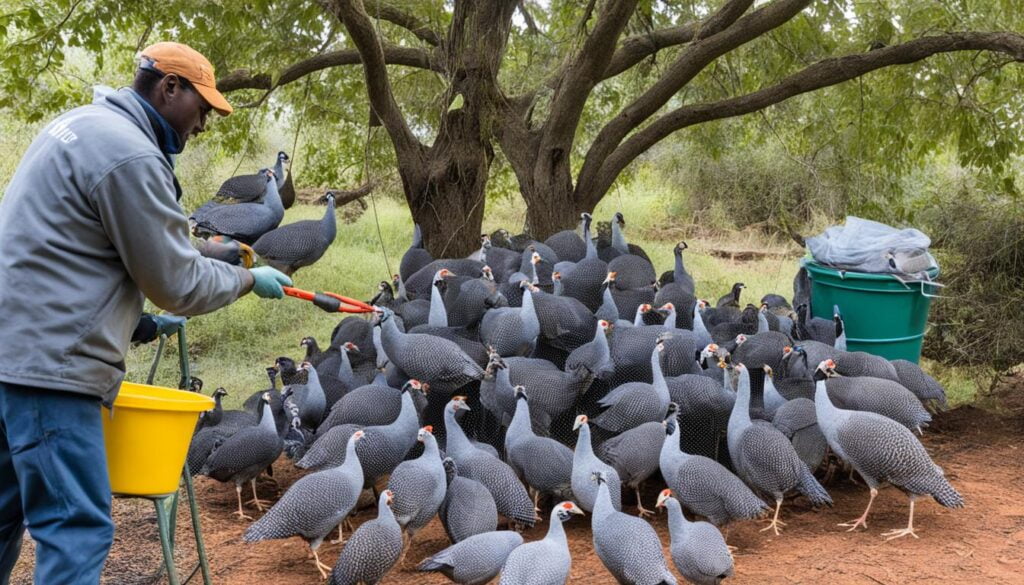To catch guinea fowl, strategic trapping techniques centered on their behavior and comfort are most effective. As you tend to your backyard farm, a foundational understanding of how to catch guinea fowl might be on your agenda, especially given that these birds can provide excellent pest control and add vibrancy to your living ecosystem. They are known for their nimbleness and acute survival instincts, which necessitates employing the best ways to capture guinea fowl without causing them stress or discomfort. Utilizing guinea fowl trapping techniques that align with their natural behaviors increases your chances of success. Whether through creating an appealing habitat to which they’ll want to return or through gentle handling, your approach to guinea fowl hunting tips and guinea fowl catching methods should be thoughtful and informed.
Key Takeaways
- Understanding guinea fowl behavior is vital for implementing successful catching methods.
- Carefully selected trapping techniques can encourage guinea fowls to return home without distress.
- Patience and consistency in training can lead to seamless integration of guinea fowl into your farm life.
- Adapt your environment to cater to their needs, thus making your property an inviting space for these birds.
- Regularly monitor the wellbeing of the birds during the capture and training processes to ensure a healthy flock.
Understanding Guinea Fowl Behavior for Effective Trapping
As you tend to your backyard setup, mastering effective guinea fowl capture strategies becomes essential. These birds present a fantastic hobby farm adventure with their intriguing habits and autonomous nature. Setting up an environment conducive to successful trapping not only benefits your farm ecosystem but also ensures the safety and happiness of your feathered friends.
Recognizing Guinea Fowl Habits and Habitat Preferences
Originating from the wild terrains of Africa, guinea fowl possess an innate desire for freedom and extensive roaming. To align with these natural inclinations, replicating their preferred habitat on your farm is paramount. These birds thrive in spaces where they can forage and explore, which is why a vast, open area rich in biodiversity can cater to their curious and active lifestyle. By understanding these preferences, you can deploy guinea fowl trapping equipment that works with their behavior, rather than against it.
Training Guinea Fowl to Adapt to Your Farmstead
Training is pivotal when it comes to trapping guinea fowl safely. Early introduction to their future housing setup is advisable, especially when starting with keets. This early home recognition helps the birds develop a strong bond with their environment, thereby reducing the likelihood of them wandering off. Gradual adaptation can convert a seemingly insurmountable task into a manageable, harmonious process.
The Role of Diet in Attracting Guinea Fowl Back Home
A proper diet is a tantalizing hook for guinea fowl, one that can lure them back to the safety of their coop. Their need for high-protein nourishment significantly trumps that of other poultry, making it a critical factor in their trapping and training. Starting with nutrient-rich food like warm heavy-protein crumbles and progressively moving to standard adult feed can play a significant role in the ease of their capture. Appeal to their innate flocking instincts by allowing one bird at a time to familiarize themselves with your farm, thus setting an example for others to follow suit.
| Attribute | Description | Benefit |
|---|---|---|
| Foraging Space | Open area allowing natural behaviors | Happy, well-adjusted birds less likely to stray |
| Diet | Heavy in protein for keets, transitioning into adult feed | Greater attraction to home coop, aiding in capture and return |
| Training | Introduction to coop, gradual exposure to farm | Increased sense of security and home, reducing escape attempts |
| Equipment | Non-invasive trapping tools aligned with guinea behavior | Safe capture without causing distress to the birds |
By attending to the distinctive behaviors of guinea fowl, you can craft an environment that encourages them to thrive under your care. Embrace the role of a patient and perceptive hobby farmer, one who understands that the details in habitat, diet, and gentle training are what lead to effective, humane, and successful trapping endeavors.
Guinea Fowl Trapping Equipment Essentials
When you’re faced with the task of catching wild guinea fowl, having the correct guinea fowl trapping equipment is not just a convenience—it’s a necessity. Navigating the tricky business of capturing these swift birds without causing them stress or harm requires tools specifically designed for the job. Consider nets with a fine mesh, which prevent injury to the guinea fowl’s delicate feathers and limbs. Employing gentle handling techniques is equally important to ensure that once caught, the guineas remain calm and unharmed. These methods resonate with responsible hobby farmers who prioritize the welfare of their avian charges.
A crucial component in the strategy for guinea fowl catching methods is the design of the coop itself. By constructing a safe, welcoming, and comfortable environment, you encourage the guinea fowl to enter and remain within their new home willingly. Ensure the coop has ample perches for roosting, sheltered areas for security, and proper bedding to insulate against the cold. A well-maintained coop, with lukewarm water to prevent cold stress and an absence of dampness and mold, promotes health and comfort. These elements are vital in convincing guinea fowl to stay close to home, effectively reducing the need for frequent captures.
Your dedication to creating a bird-friendly habitat reflects your commitment as a hobby farmer to an ethical and enjoyable farming experience. By implementing these techniques and utilizing the right trapping equipment, capturing guinea fowl becomes a smooth and efficient process, showcasing your expertise and compassionate approach to animal husbandry. Remember, the goal is to make your farm a place of safety and delight for your guinea fowl, ensuring that these fascinating birds become a harmonious part of your vibrant backyard ecosystem.

